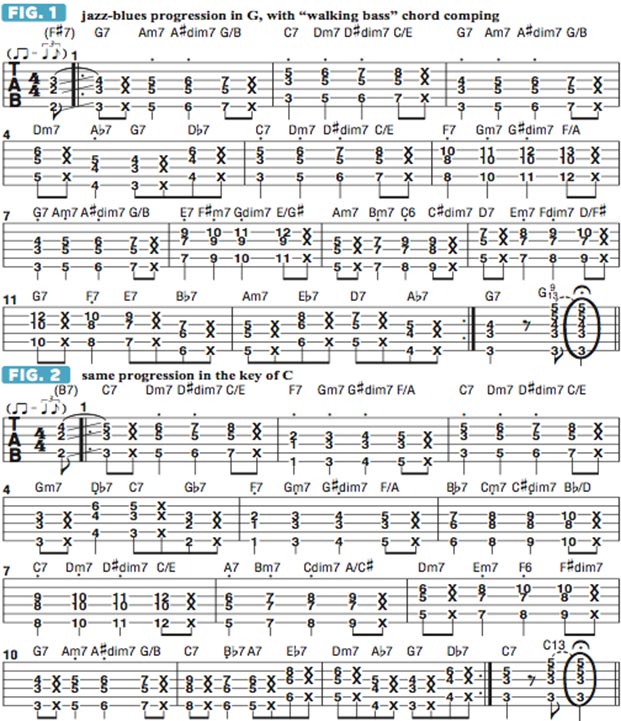Combining "Walking Bass" and "Flat-Four" Comping on Jazz-Blues Changes

Last month, I presented some neat chord substitutions to play over a 12-bar jazz-blues progression in the key of G, using sparse, three-note “shell voicings” and big-band–style “flat four” strumming, inspired by Count Basie Orchestra guitarist Freddie Green.
I then showed you a cool alternative approach to comping (accompaniment) that has you employing hybrid picking (pick-and-fingers technique) to play a constant-motion “walking bass line” complemented by rhythmically sparse, syncopated horn-section-style chord “stabs,” which together create an exciting swing-feel accompaniment that doesn’t sound too “thick” or overbearing behind a soloist.
I’d now like to offer a different and equally cool comping approach that combines flat-four chord strums and walking bass, with a different chord change falling on every beat and lots of passing chords added.
FIGURE 1 demonstrates this approach performed in our familiar key of G. As we had done in FIGURE 1 last month and in both examples from the previous month’s column (June 2016), we’re again strumming simple, three-note shell voicings that include only the chord’s root, third and seventh, with an unused, fret-hand-muted string sandwiched between the lower two notes, and adding an occasional muted-string “hiccup” strum on an eighth-note upbeat (with an upstroke) to convey the desired swing groove. Most of this 12-bar figure is based on the ascending four-chord “walk-up” pattern introduced in bar 1, which is then transposed to different “temporary tonal centers.”
What we’re doing in bar 1 is progressing from the one chord (G7) to the two minor-seven (Am7), followed by the sharp-two diminished seven (Asdim7), which serves as a transitional passing chord that resolves satisfyingly to what’s called the one chord in first inversion, meaning its third is in the bass (G/B). We then, in bar 2. apply this same walk-up pattern to the four chord, C7, this time on a different string group. Our initial pattern is then played on G7 again in bar 3, and recalled once more in bar 7. Bar 5 is a restatement of bar 2 (on C7), and our pattern is also applied to three other tonal centers: the flat-seven chord, F7, (in bar 6), the six chord, E7 (bar 8) and the five, D7 (bar 10).
Bar 4 features a “two-five to four”—Dm7 G7 C7—with chromatic passing chords inserted on beats two (Af7) and four (Df7) to keep the “walk” going. Bar 9 is a variation on our initial pattern, beginning on the two chord (Am7) and walking up to the five (D7). The progression ends with a turnaround in bars 11 and 12, incorporating more chromatic passing chords, two of which, Bf7 and Af7, are tritone substitutions for their predecessors.
FIGURE 2 shows the very same progression transposed to the key of C and offers an additional handful of useful chord shapes. Study both figures, then try playing just the two outer notes of each chord as 10th intervals, using hybrid picking, or just the walking bass line, adding open-string pull-offs as “ghost notes,” as we did in FIGURE 2 last month.
String Theory August 2016 FIGURE 1
String Theory August 2016 FIGURE 2

Get The Pick Newsletter
All the latest guitar news, interviews, lessons, reviews, deals and more, direct to your inbox!
Over the past 30 years, Jimmy Brown has built a reputation as one of the world's finest music educators, through his work as a transcriber and Senior Music Editor for Guitar World magazine and Lessons Editor for its sister publication, Guitar Player. In addition to these roles, Jimmy is also a busy working musician, performing regularly in the greater New York City area. Jimmy earned a Bachelor of Music degree in Jazz Studies and Performance and Music Management from William Paterson University in 1989. He is also an experienced private guitar teacher and an accomplished writer.










![Joe Bonamassa [left] wears a deep blue suit and polka-dotted shirt and plays his green refin Strat; the late Irish blues legend Rory Gallagher [right] screams and inflicts some punishment on his heavily worn number one Stratocaster.](https://cdn.mos.cms.futurecdn.net/cw28h7UBcTVfTLs7p7eiLe.jpg)
